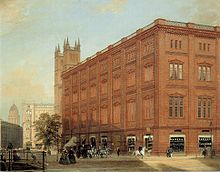
Bauakademie
Encyclopedia


Berlin
Berlin is the capital city of Germany and is one of the 16 states of Germany. With a population of 3.45 million people, Berlin is Germany's largest city. It is the second most populous city proper and the seventh most populous urban area in the European Union...
, Germany
Germany
Germany , officially the Federal Republic of Germany , is a federal parliamentary republic in Europe. The country consists of 16 states while the capital and largest city is Berlin. Germany covers an area of 357,021 km2 and has a largely temperate seasonal climate...
, built between 1832 and 1836, is considered one of the forerunners of modern architecture due to its theretofore uncommon use of red brick and the relatively streamlined facade of the building.
Designed by Karl Friedrich Schinkel
Karl Friedrich Schinkel
Karl Friedrich Schinkel was a Prussian architect, city planner, and painter who also designed furniture and stage sets. Schinkel was one of the most prominent architects of Germany and designed both neoclassical and neogothic buildings.-Biography:Schinkel was born in Neuruppin, Margraviate of...
, the Bauakademie was built near the Berliner Stadtschloss
Berliner Stadtschloss
The Stadtschloss , was a royal palace in the centre of Berlin, capital of Germany. The palace bore features of the Baroque style, and its shape, finalized by the mid 18th century, is attributed to Andreas Schlüter, whose first design is likely to date from 1702, though the palace incorporated...
(Berlin City Palace) to house institutions such as the Oberbaudeputation, the Higher Council of Architecture, and the Königliche Technische Hochschule, the technical royal faculty, which will give birth in 1879 to the Technische Universität.
For nearly 50 years (1885-1933) the Bauakademie became the home of the „Königlich Preussische Messbild-Anstalt“ since 1921 renamed in „Staatliche Bildstelle“. This institution, under its director Albrecht Meydenbauer, became the world-wide first office, professionally working with photogrammetry, establishing an archive of historical buildings, based on photography. By 1920 approximately 20.000 glass-negatives of the format 30x30cm and 40x40cm had been collected in Germany and abroad.
During the Weimar period, the Bauakademie was the home of the famous Deutsche Hochschule fuer Politik as well as other institutions supported by the State of Prussia.
Damaged during World War II
World War II
World War II, or the Second World War , was a global conflict lasting from 1939 to 1945, involving most of the world's nations—including all of the great powers—eventually forming two opposing military alliances: the Allies and the Axis...
, the Bauakademie was then partially restored, but in 1962 the building was demolished to make room for the future Ministry of Foreign Affairs of East Germany.
In 1995, the Ministry of Foreign Affairs of East Germany was demolished in order to recreate the Werderscher Markt area. Since then, proposals to rebuild Schinkel's Bauakademie have been discussed with city and Federal authorities. The Werderscher Markt area has already been partially recreated by the Bertelsmann
Bertelsmann
Bertelsmann AG is a multinational media corporation founded in 1835, based in Gütersloh, Germany. The company operates in 63 countries and employs 102,983 workers , which makes it the most international media corporation in the world. In 2008 the company reported a €16.118 billion consolidated...
-funded reconstruction of the Alte Kommandantur
Alte Kommandantur
The Alte Kommandantur is a building in the historic center of Berlin, which had been heavily damaged during World War II and destroyed in order to make room for the Ministry of Foreign Affairs of East Germany....
. As for the Bauakademie, between 2000 and 2001 students erected a temporary structure to give an impression of the volume and form of the building. Current proposals under consideration intend to use a reconstructed Bauakademie to accommodate an architecture museum as well as a Mercedes-Benz research institute about the future of automobile.
The cost of the project is estimated at 51 million euros.
External links
- Internationale Bauakademie Berlin
- http://www.schinkelsche-bauakademie.de

